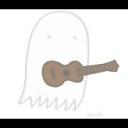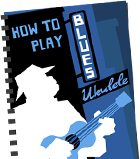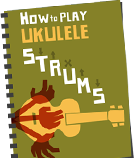A couple of weeks ago Mike asked me for one or two tips for ukulele beginners. My brain went whiring into action (actually, is was more a nasty screetching and cracking of gears). I ended up with a big list of stuff. So here, in their original, un-rewritten and bloated form, are all of them.
1. Record yourself playing and listen back to it. It’s difficult to play and listen to yourself at the same time. Quite often just noticing what you’re doing wrong is enough to fix the problem. It also gets you used to playing infront of the mic – making it less of a big deal when you want to record yourself properly.
2. Much to the RIAA’s disgust, you can’t sue someone for stealing a chord progression. Although Metallica tried to sue the band Unfaith for changing from F to E. If you hear something you like, work it out and steal it.
3. Practice so slowly you can’t possibly make a mistake. If you make the same mistake over and over again, it’s incredibly hard to get rid of it. It’s much easier to start slow, get the tune under your fingers and gradually speed up. If you’re more consciencious than me, you’ll use a metronome while you’re doing this sort of thing.
4. Learn how to read ukulele tab. There are plenty of people around who can play the ukulele without learning to read tab. But there’s so much ukulele tab around on the net now that it’s really going to increase the speed that you can pick up new tunes.
5. Once you’ve decided you enjoy the ukulele, get a nice one. Almost everyone starts of playing on a very cheap ukulele. These ukes are fine for deciding if playing the ukulele is for you. But once you’re into it, get yourself a decent quality ukulele. It’ll be easier to play, sound better (so you’ll be more pleased with the way you sound), and will give you more impetus to practice.
6. The type of strings you use can make a big different to the sound of your ukulele. The strings you get with your ukulele are likely to be cheap and nasty. It’s worth replacing them with higher quality strings such as Worth or Aquila.
7. Don’t hold your ukulele too tightly. The ukulele is small and it’s very easy to smother the sound out of it. Don’t hold it too tightly or you’ll lose a lot of volume and tone. Watch how masters like Jake Shimabukuro and hold the uke.
8. Listen to lots of ukulele players. The more you listen, the more you’ll get a feel for the ukulele and the way it sounds. It will influence how you play subconsciously.
9. Take the time to tune up properly. The ukulele isn’t the easiest instrument to get in tune and keep in tune, but it has to be done. If your ukulele is out of tune, you WILL sound terrible. I’m looking at you, Mr Merritt.
10. Enjoy yourself. The big appeal of the ukulele is that it is the most fun instrument around. People try to denigrate the ukulele as a toy. I think calling the uke a toy is a huge compliment. Toys are fun to play with and so is the ukulele.
If you want more beginners’ tips, you can find 101 of them in my ebook Ukulele 101.
 Having got my hands on my new ukulele (I went with the Sandalwood Bugsgear EleUke), my UAS has temporarily abated – I give it about six minutes. However, thanks to Heather sending me a scan of her copy the sheet music to Play A Little Low-Down Tune, my eye has turned towards ukulele song sheets.
Having got my hands on my new ukulele (I went with the Sandalwood Bugsgear EleUke), my UAS has temporarily abated – I give it about six minutes. However, thanks to Heather sending me a scan of her copy the sheet music to Play A Little Low-Down Tune, my eye has turned towards ukulele song sheets. If you’ve ever wondered where the striking picture on Richard Gillman’s page came from, take a look at the cover of Crazy Words, Crazy Tune Vo-Do-De-O. You can also see it peeking through in this job lot of sheet music (which has got a few other gems in).
If you’ve ever wondered where the striking picture on Richard Gillman’s page came from, take a look at the cover of Crazy Words, Crazy Tune Vo-Do-De-O. You can also see it peeking through in this job lot of sheet music (which has got a few other gems in).








